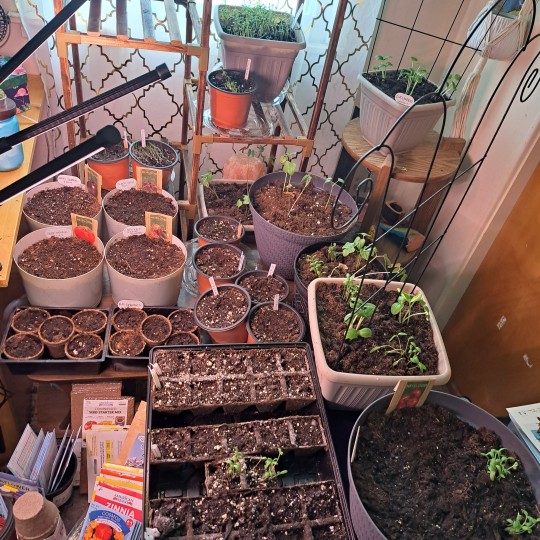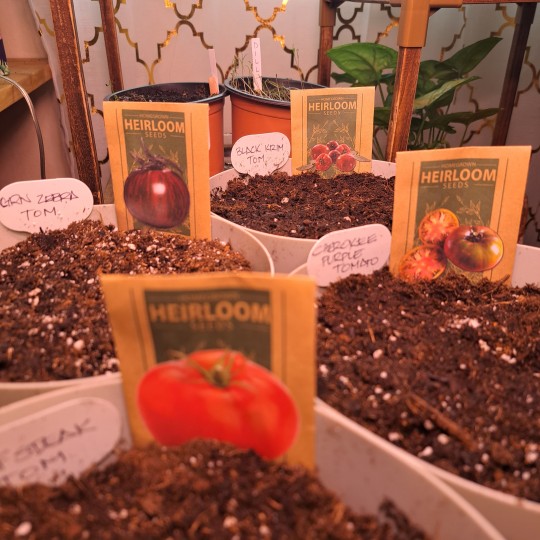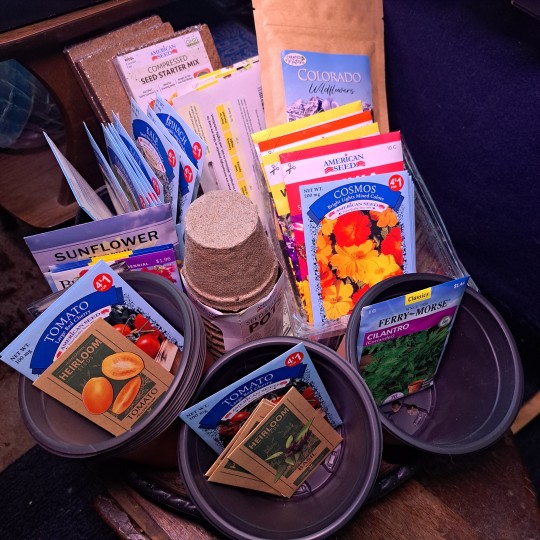#Urban Farming
Explore tagged Tumblr posts
Text
very very sickly and in a lot of chronic pain today but look how happy the kitchen cherry tomatoes, hot peppers, & ground cherry plants are!








all seeds bought from @tomorrowsgardennc 🌱🩷
#hobby: gardening#gardening#gardenblr#garden blog#garden#potted plants#potted garden#hot peppers#peppers#pepper plant#pepper#tomato plant#cherry tomatoes#tomato#tomatoes#ground cherry#ground cherries#urban homesteading#homesteading#homestead#urban farming#urban gardening#grow food#growing food
85 notes
·
View notes
Text
"We've been working on creating a more commercially resilient and sustainable urban farming system that benefits farmers, our environment and our health," says James Yin, CEO of V+ Agritech, a Singapore-based startup combining agrivoltaics and aquaponic systems.

"Since August last year, we have been testing different vegetables and collecting data on solar radiation to understand how it affects plant growth and biomass. It's incredibly critical to ensure the crops can thrive under the shading of solar panels while still receiving enough light and nutrients to grow." The combination of crop shading and the generation of renewable energy received a growing amount of interest from clients and investors.

"We're working on integrating our farming systems into spaces like hotels, hospitals, and logistics centers, while also exploring ways to incorporate educational and rehabilitative elements into our projects."
45 notes
·
View notes
Text
As urban populations boom, urban agriculture is increasingly looked to as a local food source and a way to help combat inequitable food access. But little is known about how productive urban agriculture is compared to conventional, rural farming. A new study digs in, finding urban gardeners and hydroponics can meet and sometimes exceed the yields of rural farms. “Despite its growing popularity, there’s still quite a lot we don’t know about urban agriculture, like whether the yields are similar to conventional agriculture, or even what crops are commonly grown,” says Florian Payen, an environmental scientist at Lancaster University and lead author of the study, published today in AGU’s journal Earth’s Future. The new study compiles studies on urban agriculture from 53 countries to find out which crops grow well in cities, what growing methods are most effective, and what spaces can be utilized for growing. The researchers find that urban yields for some crops, like cucumbers, tubers and lettuces, are two to four times higher than conventional farming. Many other urban crops studied are produced at similar or higher rates than in rural settings. Cost efficiency remains an open but important question. Most studies on urban agriculture have focused on green spaces, such as private and community gardens, parks and field growing operations. Payen’s work includes “gray” spaces — places in cities that are already built but could be used for growing, such as rooftops and building facades. In both green and gray spaces, the study examines a suite of crops grown in soils versus hydroponics, horizontal versus vertical farming, and natural versus controlled conditions. “Surprisingly, there were few differences between overall yields in indoor spaces and outdoor green spaces, but there were clear differences in the suitability of crop types to different gray spaces,” Payen says. Certain crops like lettuces, kale and broccoli are more naturally suited to be grown vertically in indoor spaces than others. “You can’t exactly stack up apple trees in a five- or ten-layer high growth chamber,” he says, “though we did find one study that managed to grow wheat stacked up like that.” Other crops, like watery vegetables (e.g., tomatoes) and leafy greens, performed well in hydroponic environments. And crops grown in fully controlled environments can be grown throughout the year, allowing harvests to happen more times per year than in open-air environments, which leads to higher annual yields. But scientists will need to keep studying these systems to plan cost-effective agriculture solutions. The finding that urban agriculture can have similar or greater yields to conventional agriculture “is exactly what we have been waiting for in the urban agriculture research community,” says Erica Dorr, an environmental scientist at AgroParisTech who was not involved in the study.
866 notes
·
View notes
Text


Little Free Greenhouse in Portland
82 notes
·
View notes
Text








Detroit Become Human (2018)
#detroit become human#cyberpunk#video games#cyberpunk aesthetic#gaming#scifi games#artificial intelligence#androids#interactive story#scifi aesthetic#gifs#gifset#dbh#dbh connor#blade runner#rooftop#farming#urban landscape#urban farming#urban agriculture
91 notes
·
View notes
Text
Actually, I love that cottagecore has given Gen Z a word for "I want to have a big garden and cook my own food and keep chickens" that isn't casually invoking colonialism and manifest destiny. I get so goddamned uncomfortable every time someone refers to their urban hobby farm as a "homestead" and I'm glad to finally see it being replaced with other terms. I will buy a million books about how to live a cottagecore lifestyle if it will convince publishers to stop marketing the "homesteader" lifestyle and will get white city dwellers to stop unironically self-identifying as colonizers.
#like??? words mean things#anyway#kill the cringe#cottagecore#cottage vibes#cottage life#slow living#slow life#simple living#homesteading#urban farming#hobby farm#solarpunk#gardening#self sufficiency#farmcore#mine
898 notes
·
View notes
Text
We can get through this...Gardening can help.
Y'all...how we getting through this next four years? How are we going to survive, let alone thrive?
I honestly have no idea and I am scared, but I have decided that all I can do is keep things right in my household and get back to basics.

I'm not spending my money in Trump's economy. It feels unstable and I think we are going to need every penny we have tucked away from the just in-case-ies.
All that being said. I have decided to start cooking at home more, making our bread, buying basic foods in bulk, significantly less eating out, that type of thing.
I am also going to start my seeds earlier this year. I think being able to grow a few staples, tomatoes, lettuces, maybe onions and potatoes, a few peppers. Nothing too crazy. Every year I aim too high and I spread my ADHD self too thin. I am going to focus on just a few crops and a clean and tidy yard.
I refuse to cave to these upcoming dark times. I will protect my mental health. I will garden, I will create things. I will teach myself macrame and make myself read all of the books I have bought over the years and never touched again.
Like, I bought a macrame book and some different sized ropes a few years ago...never tried to make even one thing! Well, not any more! I'm making shit!

The next four years are going to be the apex of growth in my household and I hope your's too!
Be safe everyone! I love you!
(neither of those pictures are mine, they are both aspirations)
#urban gardening#gardeners on tumblr#gardenblr#economy#mental health#crafts#stay sane#love each other#macrame#dark times#green thumb#urban farming#container gardening
29 notes
·
View notes
Text
"It’s time we broaden our understanding of what urban farms can offer. While addressing food insecurity is undeniably important, these spaces’ cultural and social dimensions are equally vital."
In Baltimore, Urban Farming Isn't Just About Growing Food
#farming#suburbia farming#suburbian agriculture#suburban agriculture#suburban farm#urban homesteading#urban gardening#urban farming#food not lawns
28 notes
·
View notes
Text

the garden yesterday morning 🌄 🌻
#hobby: gardening#gardening#garden#gardenblr#garden blog#raised garden beds#urban gardening#urban homesteading#urban farming#plantblr
41 notes
·
View notes
Text

A New Future in Urban Farming in NIgeria
The severity of this problem is felt most acutely in cities, but the solution could lie within them too. Ebenezer Howard, in his 1898 book To-morrow: A Peaceful Path to Real Reform (later revised and reprinted in 1902 as Garden Cities of To-morrow), proposed practical solutions to the overcrowding and industrial pollution of Victorian cities by creating self-sufficient suburban cities surrounded by agricultural lands.
Pre-colonial African towns were similarly bordered by farmlands, as people were mostly subsistence farmers. Even with the advent of urbanization, post-independence, urban and peri-urban farms were a key feature across African cities. City residents cultivated varying sizes of plots from backyard farms to appropriated cul-de-sacs and a few hectares of peri-urban farms on the edge of the city where residents grew vegetables like spinach, bell peppers, pumpkin leaves, and tomatoes. These offered a degree of self-sufficiency for most cities. Sadly, all of these have been lost to the mindless urbanization that has characterized the last half-century.
No city in Nigeria has integrated food systems into their urban fabric, yet the growing population, security, climatic, and economic challenges necessitate a new way of thinking to mitigate the effects of climate change and its impact on food production. Urban farming offers us a lifeline. There is the potential for big cities such as Abuja and Lagos to produce a quarter of their vegetable needs, which would bolster food security, cut prices, and reduce carbon emissions. Growing food within the cities eliminates the expensive, cumbersome and carbon-intensive logistics, while also offering organic food to residents. These initiatives will also create jobs, improve nutrition for the local population, and improve the overall quality of life for residents.
22 notes
·
View notes
Text
In a conversation with Civil Eats, lead author Jason Hawes, a Ph.D. student at the University of Michigan, said this his team compiled “the largest data set that we know of” on urban farming. It included 73 urban farms, community gardens, and individual garden sites in Europe and the United States. At each of those sites, the research team worked with farmers and gardeners to collect data on the infrastructure, daily supplies used, irrigation, harvest amounts, and social goods. That data was then used to calculate the carbon emissions embodied in the production of food at each site and those emissions were compared to carbon emissions of the same foods produced at “conventional” farms. Overall, they found greenhouse gas emissions were six times higher at the urban sites—and that’s the conclusion the study led with. But not only is 73 a tiny number compared to the data that exists on conventional production agriculture, said Omanjana Goswami, an interdisciplinary scientist at the Union of Concerned Scientists (UCS), but lumping community gardens in with urban farms set up for commercial production and then comparing that to a rural system that has been highly tuned and financed for commercial production for centuries doesn’t make sense. “It’s almost like comparing apples to oranges,” she said. “The community garden is not set up to maximize production.” In fact, the sample set was heavily tilted toward community and individual gardens and away from urban farms. In New York City, for example, the only U.S. city represented, seven community gardens run by AmeriCorps were included. Brooklyn Grange’s massive rooftop farms—which on a few acres produce more than 100,000 pounds of produce for markets, wholesale buyers, CSAs, and the city’s largest convention center each year—were not. And what the study found was that when the small group of urban farms were disaggregated from the gardens, those farms were “statistically indistinguishable from conventional farms” on emissions. Aside from one high-emission outlier, the urban farms were carbon-competitive.
182 notes
·
View notes
Text

Hey, I’m Jamila Norman, aka Farmer J – Urban Farmer, TV Host & Food Activist 🌻
For those of you just joining me here, let me reintroduce myself and share a bit of my journey. I’m a first-generation American of Caribbean parents with deep roots in agriculture. After earning my Environmental Engineering degree from UGA and spending 10 years in my professional career, I took a leap and fully committed to running Patchwork City Farms, the regenerative urban farm I founded in 2010 right here in the City of Atlanta.
My passion for healthy food equity and access goes beyond farming. I helped launch the South West Atlanta Growers Cooperative (SWAG Coop) to support Black urban farmers and build a just, sustainable food system. I also service on multiple advisory committees in partnership with the City of Atlanta and have served on the board of Georgia Organics and advocating for our local farmers through the Atlanta Farmers Coalition. I also mentor aspiring and new farmers in partnership other agricultural organizations.
I’m also the host of the Emmy Nominated show on the Magnolia network titled “Homegrown” which launched 4 seasons. In the show, I help families transform their properties into thriving gardens and farms.
I’ve been recognized as a Cherry Bombe 100 honoree, am currently a Tory Burch Foundation Fellow, and a Game Changer Honoree for The Black Woman In Food. I’m here to grow food, uplift my community, and create change thought the cultivation of vibrant regenerative spaces..
Excited to continue growing together!
13 notes
·
View notes
Text

Urban oasis 🌱
This place just makes me happy 🍎🍅🥦
#urban gardening#urban farming#permaculture#gardening#nature#food#sustainability#london#hackney#community garden#food growing
29 notes
·
View notes
Text
Foraging and dust bathing on their first day outside
17 notes
·
View notes
Text
youtube
Permaculture Instructor Andrew Millison visits the biggest rooftop farm on the West Coast of the US located in Oakland, California. Designed and built by Benjamin Fahrer of Top Leaf Farms and operated by Deep Medicine Circle, this is an impressive project bringing food production, food security, and food justice to the heart of the city.
Top Leaf Farms:
https://topleaffarms.c...
Deep Medicine Circle:
https://www.deepmedici...
#Andrew Millison#solarpunk#rooftop farm#rooftop garden#urban garden#urban farming#urban farm#farm#farming#Oakland#California#USA#Top Leaf Farms#Deep Medicine Circle#food desert#Benjamin Fahrer#Youtube
23 notes
·
View notes
Text





Ooooookaaaay Round 2! Transplanted all.of those morning glories that shot up into bigger pots.
Distributed Marigolds into Basil and tomato pots.
Got 8 cucumber shoots transplanted into their own pots.
Planted Hollyhock seeds and a varying variety of different tomato plants.
My craft room is over flowing!! I can't wait to get the greenhouse back up. Hopefully it will be done by April 15th!
#urban gardening#gardeners on tumblr#container gardening#urban farming#green thumb#gardenblr#cottagecore#greenblr#cottageblr#self sustainability#hollyhock#tomato plant#basil#dill#cilantro#marigolds#native wildflowers
61 notes
·
View notes